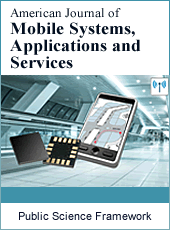American Journal of Mobile Systems, Applications and Services
Articles Information
American Journal of Mobile Systems, Applications and Services, Vol.1, No.1, Aug. 2015, Pub. Date: Jul. 9, 2015
Designing Antenna Parameters for Reduction of Co-Channel Interference in Cellular Mobile Communication by Mechanical Antenna Downtilt
Pages: 1-5 Views: 2980 Downloads: 3477
[01]
G. R. Ahmed Jamal, Department of Electrical and Electronic Engineering, University of Asia Pacific, Dhaka, Bangladesh.
[02]
Toukir Ahmed, Department of Electrical and Electronic Engineering, Primeasia University, Dhaka, Bangladesh.
[03]
M. Elias Kanchon, Department of Electrical and Electronic Engineering, Primeasia University, Dhaka, Bangladesh.
[04]
S. M. Nahid Hossain, Department of Electrical and Electronic Engineering, Primeasia University, Dhaka, Bangladesh.
The problem of co-channel interference in GSM cellular mobile communication is studied. One effective method of reducing co-channel interference, namely ‘Mechanical antenna downtilt’ is investigated. Suitable values of base station antenna parameters is calculated using MATLAB to find for reducing co-channel interference through this method. The simulation result provided suitable values for antenna height and vertical beamwidth angle to maintain the downtilt angle within optimum range for standard coverage area. These values can be used to design a real site to achieve reduced co-channel interference so as to improve the performance of cellular network.
Cellular Mobile, Co-Channel Interference, Antenna, Mechanical Downtilt, Beam Width
[01]
P. S. Rha, S. E. Kay, A. J. MacDonald, “Cellular System having Frequency Plan and Cell Layout with Reduced Co-channel interference”, U. S. Patent, 5365571, 1994.
[02]
P. SumithabhashiniandN. C. E. Reddy, “Comparison of Various Techniques for Suppression or Cancellation of Co-channel Interference in GSM”, Jnl. of Mob Comm., Vol. 2, Issue: 3, pp. 73-77, 2008.
[03]
A. Hasan, S. L. Reinhold, R. Ramesh, “Method for Improving Co-channel Interference in a Cellular System”, U. S. Patent, 5946625, 1999.
[04]
S. Chennakeshu, S. L. Reinhold, “Method and Apparatus for reducing co-channel Interference”, U. S. Patent, 6091936, 2000.
[05]
T. S. Rappaport, “Wireless Communications: Principles and Practice”, Prentice Hall, 2nd Edn, 2002.
[06]
D. J. Y. Lee, C. Xu, “Mechanical Antenna Downtilt and its Impact on System Design,” 42ndIEEE VTC Proc., Vol. 2, pp. 447-451, 1997.
[07]
W. C. Y. Lee, "Cellular Mobile Radiotelephone System Using Tilted Antenna Radiation Pattern", U.S. Patent 4,249,181, 1981.
[08]
I. Forkel, A. Kemper, R. Pabst, R. Hermans, “The Effect of Electrical and Mechanical Antenna Down-tilting in UMTS network,” 3rd Intrnl. Conf. on 3G Mob. Com. Technol. Proc., pp. 86-90, 2002.
[09]
S. C. Bundy, “Antenna Downtilt Effect on CDMA Cell-site Capacity,” IEEE Radio and Wireless Conf. Proc., pp. 99-102, 1999.
[10]
J. Niemelaand J. Lempiainen, “Impact of Mechanical Antenna Downtilt on Performance of WCDMA Cellular Network”, IEEE 59thVTC Conf.Proc., Vol.4, pp. 2091 – 2095, 2004.
[11]
J. Niemela, T. Isotalo and J. Lempiainen, “Optimum Antenna Downtilt Angles for MacrocellularWCDMA Network”, J. on Wireless Comm. and Networking, Vol. 2005, Issue 5, pp. 816-827,2005.
[12]
J. Wu, D. Yuan,“Antenna Downtilt Performance in Urban Environments,” IEEE Military Comm. Conf. Proc., vol. 3, pp. 739–744, 1996.
[13]
G. E. Aderibigbe, M. O. Kolawole and V. S. A. Adeloye, “Effects of Antenna Tilting on Transmitting Power in Mobile Cellular Communication Systems”, Int. J. Comm., Net.and System Sci, Vol. 4, pp. 464-467, 2011.
[14]
H. S. Cho, Y. Kim, D. K. Sung, “Protection against Co-channel Interference from Neighboring Cells Using Down-Tilting ofAntenna Beams”, 53rd IEEE VTC Proc., pp. 1553 – 1557, 2001.

ISSN Print: 2471-7282
ISSN Online: 2471-7290
Current Issue:
Vol. 5, Issue 1, March Submit a Manuscript Join Editorial Board Join Reviewer Team
ISSN Online: 2471-7290
Current Issue:
Vol. 5, Issue 1, March Submit a Manuscript Join Editorial Board Join Reviewer Team
| About This Journal |
| All Issues |
| Open Access |
| Indexing |
| Payment Information |
| Author Guidelines |
| Review Process |
| Publication Ethics |
| Editorial Board |
| Peer Reviewers |


